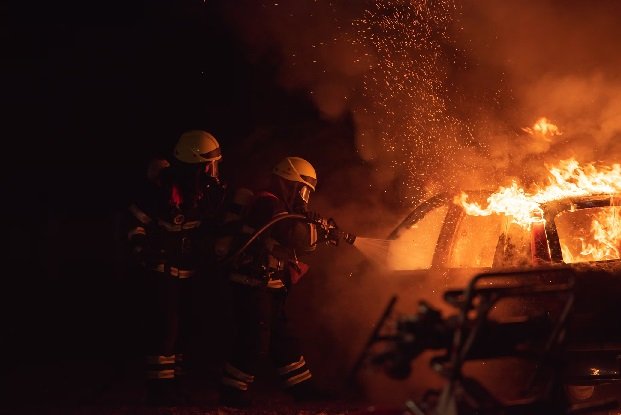Canada Might Ban Firefighting Foam: Fatal Health Hazards To Know

Firefighters, with their protective gear and tools, might paint an impressive picture of their lives. While their job requires much courage and zeal, it is also true that they have to face occupational health hazards that come from AFFF, or firefighter foam. It contains ‘forever chemicals’ that are carcinogenic. Talks are on that this foam might get banned in Canada after the federal government risk assessment where it can be labeled as toxic.
According to Steven Guilbeault, the Minister of Environment and Climate Change in Canada, human-made substances that pollute nature shouldn’t last forever. He asserted this as his department issued a draft report on PFAS (per and polyfluoroalkyl substances) chemicals contained in AFFF.
Simply put, PFAS includes over 4,700 chemicals that are used in multiple products, such as dirt and water repellents, lubricants, foams, and textiles. According to the draft report, there is substantial evidence that chemicals such as AFFF can pose health hazards. It can lead to thyroid problems, testicular and kidney cancer, skin problems, vision issues, and infertility. Since they persist in the environment and the human body, they are known as ‘forever chemicals’.
This article will discuss whether Canada aims to ban this toxic foam and the health hazards linked with it so that firefighters are aware of it and take the necessary steps.
AFFF Exposure Has a High Chance of Causing Cancer
Environmental Health Perspectives, a journal published in 2023 published a study where firefighters had been exposed to AFFF, which made them more susceptible to testicular cancer compared to others. If you’ve faced the same, you can file a firefighting foam lawsuit like many others and allege the manufacturers for your health hazards.
This toxic foam has been linked with several kinds of cancer, including:
- Breast Cancer
- Bladder Cancer
- Leukemia
- Endometrial Cancer
- Liver Cancer
- Multiple Myeloma
- Lymphoma
- Prostate Cancer
- Pancreatic Cancer
- Renal Cancer
Until a while ago, AFFF had been widely used at flight decks, airports, and military airfields. The FAA (Federal Aviation Administration) issued a performance standard that promoted the use of AFFF at every airport in the U.S. until 2018.
However, considering its widespread use, civilian firefighters, service military branches, the Air Force, firefighting trainees, first and emergency responders, fire service personnel, and industrial site workers, working with this foam were at risk of getting diagnosed with cancer.
Keeping this in mind, TorHoerman Law states that government agencies have started to work to terminate PFAS and phase out this toxic foam. Some fire departments have also opted for new-age fluorotelomer foams, which might prove to be less risky to human health and the environment.
Since AFFF is harmful to human health, the U.S. Department of Defense is trying to come up with improved PFAS-free AFFF alternatives that can extinguish flammable fires and not prove to be carcinogenic.
Will Canada Ban PFAS?
In May 2023, CP24.com shared the views of Cassie Barker, who is the toxics program manager at Environmental Defence, on PFAS and its risks. She said that it was necessary to cancel out the scope of PFAS exposure so that the existing contamination could be cleared off. She asserts that it’s the first time that Environment Canada has been reviewing various chemicals compared to a single substance.
Since these substances have already been persisting in the environment, the side effects on human health and nature will increase if the entry is continued. Based on the news report, there was a need for 60 days to look at the public remarks on the findings. After that, Environment Canada wanted to share a suggestion for the way the government should go ahead. It might be trying to regulate all or a few PFAS products, from limiting their user rights to complete bans.
Hence, it can be said that Canada might follow in the footsteps of a few U.S. states and Europe for PFAS and its product regulation. Europe too has decided to ban this foam barring a few times when using it is crucial.
Neil McMillan, the director of research and science with the International Association of Fire Fighters and also one who belonged to this profession in Ottawa, said he knows that PFAS exposure causes health hazards. He has been doing his part to ban this toxic foam for a few years. He stated that firefighters will get exposed to PFAS akin to other chemicals in multiple ways, including the protective gear they wear.
McMillan also shared that it might be challenging for firefighters to avoid certain exposures. But if they can avoid a few, it might be helpful in the future. That aside, firefighters should only use their gear when necessary otherwise, they should not.
In conclusion, most people think that firefighters arrive with their firefighting tools to extinguish the fire and then move away without getting affected. More so, because they see them wearing protective gear. They are in danger because of AFFF exposure through the fire extinguishing foam. Hence, keeping all these concerns in mind, Canada, like several other nations, is aiming to ban AFFF to reduce health hazards and create a safe environment.












